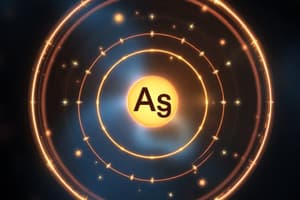Podcast
Questions and Answers
Which elements are likely to have a larger atomic radius than silicon (Si)? (Select all that apply)
Which elements are likely to have a larger atomic radius than silicon (Si)? (Select all that apply)
- Carbon (C)
- Aluminum (Al) (correct)
- Sulfur (S)
- Tin (Sn) (correct)
Atomic radii from the left to right across a period tend to increase.
Atomic radii from the left to right across a period tend to increase.
False (B)
Atomic radii from the top to the bottom of a group tend to increase.
Atomic radii from the top to the bottom of a group tend to increase.
True (A)
A sodium cation is ______ than a sodium atom.
A sodium cation is ______ than a sodium atom.
A phosphorus anion is ______ than a phosphorus atom.
A phosphorus anion is ______ than a phosphorus atom.
A magnesium ion is _____ than a sodium ion.
A magnesium ion is _____ than a sodium ion.
Ionic radii tend to decrease across a period.
Ionic radii tend to decrease across a period.
What is the predicted order of first ionization energies from highest to lowest for beryllium, calcium, magnesium, and strontium?
What is the predicted order of first ionization energies from highest to lowest for beryllium, calcium, magnesium, and strontium?
What is the predicted order of first ionization energies from highest to lowest for aluminum, phosphorus, silicon, and sulfur?
What is the predicted order of first ionization energies from highest to lowest for aluminum, phosphorus, silicon, and sulfur?
Why are the trends and exceptions to the trends in ionization energy observed? (Select all that apply)
Why are the trends and exceptions to the trends in ionization energy observed? (Select all that apply)
What are the trends and exceptions to the trends in electron affinity? (Select all that apply)
What are the trends and exceptions to the trends in electron affinity? (Select all that apply)
Select the element that has the correct relative electronegativity: Mg > ?
Select the element that has the correct relative electronegativity: Mg > ?
Electronegativity across a period increases.
Electronegativity across a period increases.
Electronegativity down a group decreases.
Electronegativity down a group decreases.
Consider the elements ______ and chlorine; which element has a larger ionic radius?
Consider the elements ______ and chlorine; which element has a larger ionic radius?
Number the elements sodium, magnesium, and potassium in the predicted order of ionic radius from the largest (1) to the smallest (3).
Number the elements sodium, magnesium, and potassium in the predicted order of ionic radius from the largest (1) to the smallest (3).
Consider the elements bromine and ______; which element has a higher ionization energy?
Consider the elements bromine and ______; which element has a higher ionization energy?
Number the elements sodium, magnesium, phosphorus, and chlorine in the predicted order of ionization energies from highest to lowest.
Number the elements sodium, magnesium, phosphorus, and chlorine in the predicted order of ionization energies from highest to lowest.
Flashcards are hidden until you start studying
Study Notes
Atomic Radius Trends
- Elements with larger atomic radii than silicon (Si) include aluminum (Al) and tin (Sn).
- Atomic radii decrease from left to right across a period due to increased nuclear charge.
- Atomic radii increase from top to bottom of a group because electrons are added to new energy levels.
Ion Sizes and Charge
- A sodium cation (Na⁺) is smaller than a neutral sodium atom (Na).
- A phosphorus anion (P³⁻) is larger than a neutral phosphorus atom (P).
- A magnesium ion (Mg²⁺) is smaller than a sodium ion (Na⁺).
- A chlorine ion (Cl⁻) is smaller than a phosphorus ion (P³⁻).
- A potassium ion (K⁺) is larger than a sodium ion (Na⁺).
Ionic Radii Trends
- Ionic radii increase down a group due to additional electron shells.
- Ionic radii decrease across a period as nuclear charge increases, attracting electrons more strongly.
- Anionic radii tend to increase across a period from left to right.
- Cationic radii decrease across a period.
- There is an increase in ionic radii when switching from cations to anions in a period.
Ionization Energy Trends
- The predicted order of first ionization energies from highest to lowest: Be > Mg > Ca > Sr.
- The predicted order of first ionization energies for aluminum, phosphorus, silicon, and sulfur: P > S > Si > Al.
Factors Influencing Ionization Energy
- Ionization energy increases down a group as electrons are further from the nucleus, resulting in weaker attractions.
- Ionization energy tends to increase across a period due to increased nuclear charge.
- Group 16 elements have slightly lower ionization energies than Group 15 due to a fourth electron added to an unfilled p orbital.
- Group 13 elements exhibit lower ionization energies compared to Group 2 due to electron shielding from a full s orbital.
Electron Affinity Trends
- Group 17 elements have larger (more negative) electron affinities than Group 1 elements.
- Electron affinities increase (become more negative) down a group.
- Group 14 elements have more negative electron affinities than Group 15 elements.
Electronegativity Trends
- Electronegativity increases across a period and decreases down a group.
- Relative electronegativities for selected elements: Mg > Ca, P > As, C < N, Br < Cl.
Ionic Radius Comparison
- Bromine has a larger ionic radius compared to chlorine.
- The predicted order of ionic radii for sodium (Na), magnesium (Mg), and potassium (K): K > Na > Mg.
Ionization Energy Comparisons
- Chlorine has a higher ionization energy than bromine.
- The predicted order of ionization energies from highest to lowest for sodium (Na), magnesium (Mg), phosphorus (P), and chlorine (Cl): Cl > P > Na > Mg.
Studying That Suits You
Use AI to generate personalized quizzes and flashcards to suit your learning preferences.



